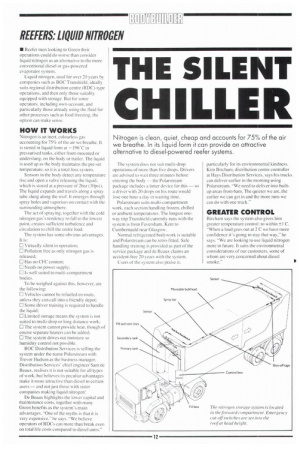THE SILENT
Page 108

If you've noticed an error in this article please click here to report it so we can fix it.
CHILLER
• Reefer men looking to Green their operations could do worse than consider liquid nitrogen as an alternative to the more conventional diesel or gas-powered evaporator system.
Liquid nitrogen, used for over 20 years by companies such as BOC Transhield. ideally suits regional distribution centre (RDC)-type operations, and then only those suitably equipped with storage. But for some operators. including own-account, and particularly those already using the fluid for other processes such as food freezing. the option can make sense.
Nitrogen is an inert, colourless gas accounting for 75ezi, of the air we breathe. h is stored in liquid form at — 196'C in pressurised tanks, either front-mounted or underslung, on the body or trailer. The liquid is used up as the body maintains the pre-set temperature. so it is a total-loss system.
Sensors in the body detect any temperature rise and open a valve releasing the liquid. which is stored at a pressure of 2bar (3Opsi). The liquid expands and travels along a spray tube slung along the roof. It emerges through spray holes and vaporises on contact with the surrounding atmosphere.
The act of spraying. together with the cold nitrogen gas's tendency to fall to the lowest point, creates sufficient turbulence and circulation to chill the entire load.
The system has some obvious advantages. It is:
0 Virtually silent in operation;
0 Pollution free as only nitrogen gas is released: 0 Has no CFC content; Needs no power supply; Is well suited to multi-compartment bodies.
To be weighed against this. however, are the following: E Vehicles cannot be refueled en route. unless they can call into a friendly depot; LI Some driver training is required to handle the liquid: 0 Limited storage means the system is not suited to multi-drop or long distance work; 0 The system cannot provide heal, though of course separate heaters can be added; 0 The system drives out moisture so humidity control not possible.
BOC Distribution Services is selling the system under the name Polarstream with Trevor Iludson as the business manager. Distribution Services' chief engineer Sam de Beaux, realises it is not suitable for all types of work, but believes its peculiar advantages make it more attractive than diesel to certain users — and not just those with sister companies making liquid nitrogen!
De Beaux highlights the lower capital and maintenance costs, together with many Green benefits as the system's main advantages. "One of the myths is that it is very expensive," he says, "We believe operators of RDCs can more than break even on total life costs compared to diesel units." The system does not suit multi-drop operations of more than live drops. Drivers are advised to wait three minutes before entering the body — the Polarstream package includes a timer device for this — so a driver with 20 drops on his route would lose one hour a day in waiting time.
Polarstream suits multi-compartment work, each section handling frozen, chilled or ambient temperatures. The longest oneway trip Transhield currently runs with the system is from Faversham. Kent to Cumbernauld near Glasgow.
Normal refrigerated bodywork is suitable and Polarstream can be retro-fitted. Safe handling training is provided as part of the service package and de Beaux claims an accident-free 20 years with the system.
Users of the system also praise it. particularly for its environmental kindness. Kim Bircharn, distribution centre controller at Hays Distribution Services, says his trucks can deliver earlier in the morning using Polarstream. "We need to deliver into builtup areas from 6am. The quieter we are, the earlier we can get in and the more runs we can do with one truck."
Birchani s s the system also gives him greater temperature control: to within ±I C. When a load goes out at 2C we have more confidence it's going to stay that way." he says. -We are looking to use liquid nitrogen more in future. It suits the environmental considerations of our customers, some of whom are very concerned about diesel smoke.
























































































































